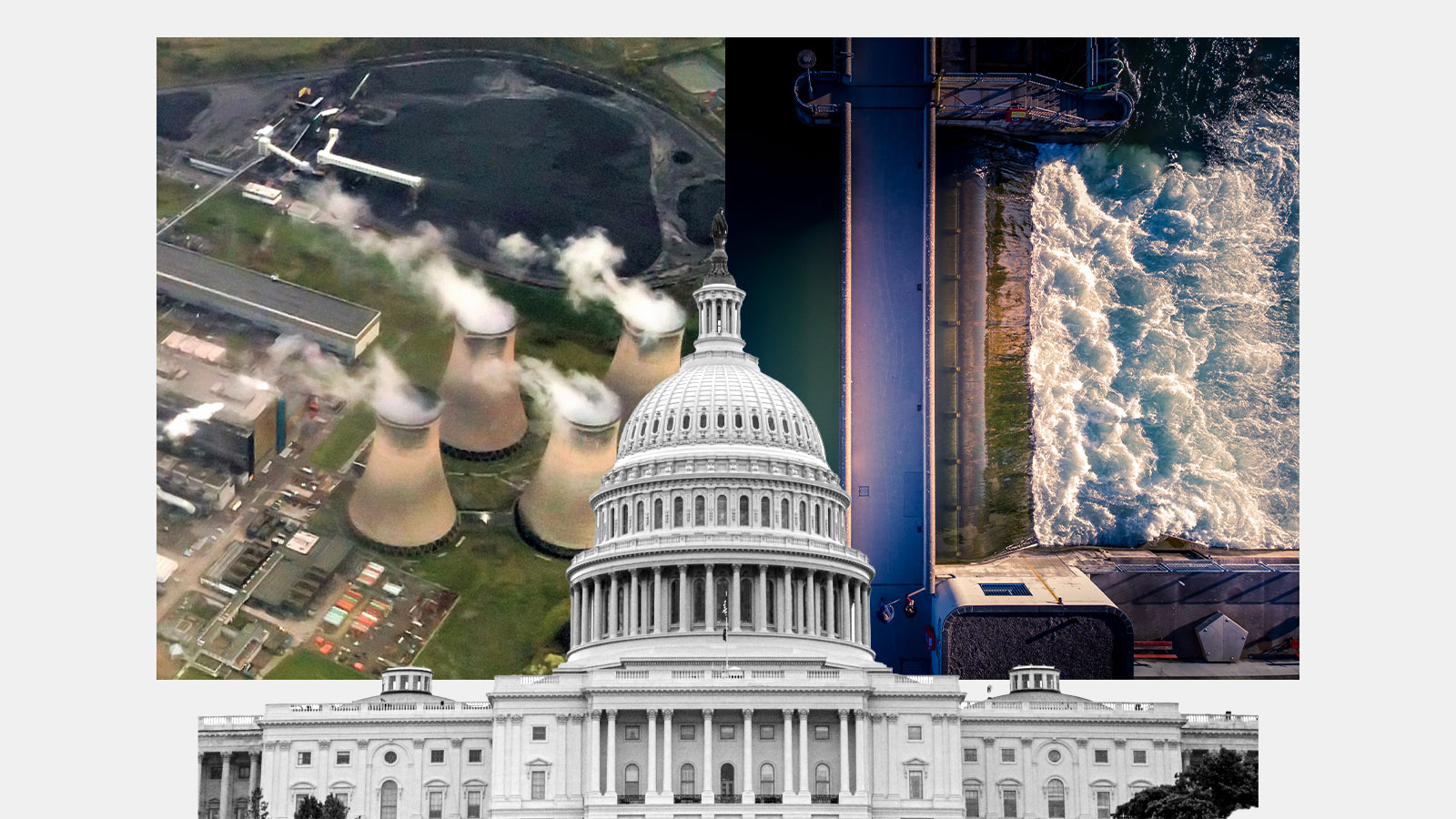When President Joe Biden unveiled his $2 trillion climate and infrastructure plan in March, Senate Minority Leader Mitch McConnell was quick to accuse the White House of “trying to use important issues as smokescreens for unrelated agendas.”
It’s true that, at first glance, Biden’s American Jobs Plan — which seeks to increase the corporate tax rate to offset its price tag — looks like anathema to Republicans. It would direct billions toward green infrastructure, green jobs training, climate change adaptation, and renewable energy programs. But a peek under the hood reveals a few green ideas legislators could actually agree on.
The proposal calls for investing in clean energy research and development and carbon capture and sequestration, both steps some climate-conscious members of the GOP have pushed for in recent years. The plan also calls for “continuing to leverage the carbon pollution-free energy provided by existing sources like nuclear and hydropower” — Republicans’ two favorite non-fossil fuel sources of energy. Democrats are big proponents of wind and solar energy, but Republicans say their intermittent nature destabilizes the grid. Republicans advocate for natural gas as a reliable alternative, which Democrats aren’t keen on. Hydroelectric power and nuclear energy, which generate a constant flow of power regardless of the weather, fit both parties’ energy prerequisites. They have mixed support among Americans but enjoy rare bipartisan popularity in Congress, with a few exceptions — notably, Democratic Senators Bernie Sanders and Elizabeth Warren have advocated for phasing out nuclear. But in general, Josh Freed, head of the climate program at the centrist policy and research nonprofit Third Way, told Grist that enthusiasm for nuclear energy and hydroelectric power on Capitol Hill is widespread.
“Nuclear and hydro are the two exceptions most Republicans have decided to include as acceptable responses to climate change,” Freed said. “There’s a lot of stuff in the American Jobs Plan that one would think Republicans could get behind even if they don’t support the underlying bill when it comes out.”
Hydro and nuclear could be useful bargaining chips for the White House. If Biden can use funding for hydro and nuclear, as well as incentives for carbon capture and sequestration, as a means of getting even a few Republicans to support his plan, he’ll have an easier time getting the moderates in his party to sign on to the package, too. Joe Manchin, the senior senator from West Virginia and one of the most conservative Democrats in Congress, has been pressuring Biden to work with Republicans on infrastructure before pursuing other means of passing the proposal. He’s indicated might even vote against the package if Democrats don’t try to reach across the aisle.
Meanwhile, young Republicans are getting fed up with their party’s obsolescent stance on climate change, a fact that House Minority Leader Kevin McCarthy says Republicans should be “nervous” about. Republicans don’t need to embrace Biden’s infrastructure plan to appeal to young conservatives, but they do need to develop a cohesive energy policy in order to stay relevant. McCarthy has been cooking up a GOP response to Democrats’ myriad climate plans, and parts of it may overlap with Biden’s infrastructure plan.
Biden now has to figure out how to motivate both sides of the aisle to make progress on the overlapping bits of their agendas. That might seem like a tall order for a Congress that doesn’t agree on much, but it’s already happening here and there.
In 2019, Senator Lisa Murkowski, Republican from Alaska, introduced the Nuclear Energy Leadership Act. It directs the Department of Energy to invest in advanced nuclear projects — new nuclear reactors that come in a range of sizes and can do things like process heat and desalinate water in addition to providing carbon-free electricity. The bill was cosponsored by Democratic Senator Cory Booker, from New Jersey, and got more than a dozen other bipartisan cosponsors. It passed as an amendment to the 2021 National Defense Authorization Act. The 2020 Energy Act, the most significant piece of clean energy legislation in over a decade, also passed with bipartisan support in both chambers of Congress. It includes major investments in both nuclear and hydro. Those successes hint that more bipartisan agreements could be forged.
Last month, Manchin, chair of the Senate Committee on Energy and Natural Resources, held a hearing on nuclear energy. “We cannot afford to let this carbon-free energy resource fade out,” he said. The ranking Republican on the committee, Senator John Barrasso of Wyoming, who has voted against almost every single climate-related measure the Senate has considered since he was sworn in in 2007, gave a full-throated endorsement of nuclear energy. “Now more than ever, Washington must advance policies to preserve and expand the use of nuclear energy,” Barrasso, who successfully shepherded his own nuclear bill through the Senate in 2018, said. “Nuclear technology is fundamental to meeting our energy, our environmental, and our national security goals.”
In early March, Democrats on the House Energy and Commerce Committee unveiled a broad climate bill that included a measure to eliminate emissions from the electricity sector by 2035. The Republicans on the committee called the plan a “rush to green with one-size-fits-all regulations,” but they said they were interested in working with Democrats toward eliminating emissions, primarily by expanding investment in innovation, nuclear power, and hydroelectricity. The bill includes a nuclear power purchasing program and improvements to hydropower regulatory and leasing processes.
There’s reason to believe Republicans on the committee are serious about working with Democrats on advancing nuclear energy and hydropower. A Republican on the committee, Representative David McKinley from West Virginia, previously introduced a bill that aims to slash emissions 80 percent by 2050. It includes provisions that would electrify existing dams and invest in advanced nuclear. The ranking Republican on the committee, Cathy McMorris Rodgers of eastern Washington, introduced a bill promoting hydroelectric power last year. It didn’t make it to the House floor for a vote before the 116th Congress ended, but McMorris Rodgers, whose state heavily relies on hydro, remains a staunch supporter of electrifying dams.
“It really does seem like we’re kind of on the verge here of a big bipartisan consensus,” Rich Powell, executive director of the conservative clean energy think tank ClearPath, told Grist.
The question now is whether Biden will be able to use these existing areas of agreement as a springboard for his infrastructure package. On Monday, he met with a group of bipartisan senators in the Oval Office. “Roads, bridges, and ports are undoubtedly infrastructure, and I believe that energy grids, broadband, and clean water can fit the definition as well,” Representative Don Young, a Republican from Alaska and one of the legislators who attended the meeting, told reporters afterward. He noted that expanding the plan’s scope beyond those items “could sink the bill,” and other Republicans agree with him. Over the past couple of weeks, Republicans have rallied behind the claim that only a small percentage of Biden’s plan concerns “real infrastructure” — that is, bridges, tunnels, and roads. The White House has been quick to point out that rail, water lines, the electric grid, and broadband are also critical infrastructure. (Republicans used to think some of those things were infrastructure, too.) Biden says he’s open to customizing his proposal to Republican specifications, within reason.
“Democrats are eager to get Republicans to work with them on anything that will help address climate change,” Freed said. “That’s because the Democratic party writ large has really adopted an approach of a multitude of options, because that’s what we need at this point.”Biden might have a better idea of what those options are once Republicans have a coherent energy policy of their own to tout. Later this month, Representative McCarthy is expected to unveil the climate plan he’s been working on, which could include “research and development of low-emissions sources of power as well as the development of carbon capture technologies and natural gas plants,” according to Bloomberg News. The plan almost certainly won’t do enough to curb emissions, but it may accomplish something politically significant: establish a few inches of common ground on climate change. At the end of the day, that foothold may be all Biden needs to generate momentum for his plan.




